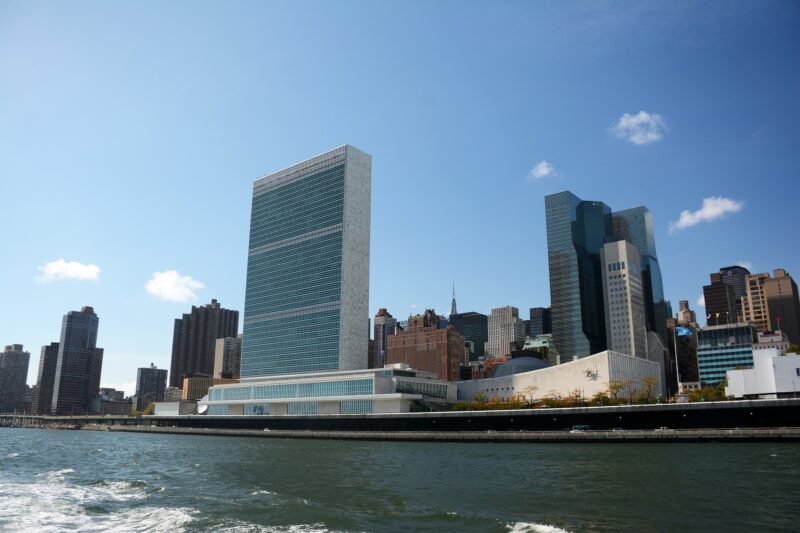Paris Agreement’s 1.5°C limit – a key SDG enabler
Dr Carl-Friedrich Schleussner, Laetitia De Marez
Share

2017 was marked with not only record high temperatures but also with many climate-related disasters that hit communities and economies of developing countries especially hard – from floods in South East Asia and torrential rains that led to deadly landslides in West Africa, to an unprecedented Atlantic hurricane season, which wiped out whole Caribbean islands.
A recent event at the UN Headquarters in New York, organised by the Government of Belize, brought together UN diplomats and experts working on climate change and development agendas for a necessary discussion about the political, policy and financing steps needed to get onto a 1.5°C pathway, and the ways to maximise synergies between climate pledges under the Paris Agreement (NDCs) and the implementation of the 2030 Sustainable Development Agenda.
2018 is a particularly important year for climate action ambition. A major political dialogue, the Talanoa Dialogue, decided at the Fiji Climate Conference in December 2017, intends to take stock of and share what governments are doing and how much more they need to do to be in line with Paris Agreement goals. This Dialogue will conclude at the November climate summit, COP24, in Poland. “It would be remiss if the development community and development policy makers did not provide strong input into that dialogue,” said H. E. Ambassador Lois M. Young, who hosted and moderated the event.
The Talanoa Dialogue is structured around three questions: Where are we? Where do we want to go? How do we get there? In response to the first question, Climate Analytics’ Dr Carl-Friedrich Schleussner presented the latest science about climate impacts occurring now, at 1°C of warming above pre-industrial levels.
2017 was the costliest year so far in terms of weather-related disasters – with damages over 330 billion USD. Recent World Economic Forum analysis shows the heaviest GDP losses are in low-income countries.
Extreme weather events such as drought, flooding, cyclones, are also displacing millions of people: 23.5 million just in 2017 alone, and a total of 227.6 million in 2008-2016.
Scientists are increasingly confident in attributing extreme weather events to climate change. For example, warmer ocean waters in the North Atlantic contributed to the increasing the intensity of tropical cyclones in 2017.
As sea-level temperatures have increased, so have the number of category 5 #cyclones & #hurricanes. Clear linkages with #ClimateChange –
CA_Latest</a> Carl-Friedrich Schleussner <a href="https://twitter.com/carlvmercer?ref_src=twsrc%5Etfw">carlvmercerUNDPasiapac</a> <a href="https://twitter.com/ScheuerJo?ref_src=twsrc%5Etfw">ScheuerJoPNUDLAC</a> <a href="https://t.co/p23PS9vQsI">pic.twitter.com/p23PS9vQsI</a></p>— UNDP Climate (UNDPClimate) 5 February 2018
While we understand better the link between extreme events and climate change, the level of climate action remains massively inadequate to avoid dangerous level of warming. There’s an alarming gap between emission reductions aggregated from countries’ pledges (NDCs) and what is needed to meet the objectives of the Paris Agreement. The analysis by the Climate Action Tracker shows that only two countries analysed have put forward 1.5°C-compatible climate pledges.
Most vulnerable countries, such as Small Island Developing States and Least Developed Countries, have a clear answer to the Talanoa Dialogue’s second framing question – where do we want to go? – stay below 1.5°C.
The importance these countries place on this lower limit is backed by a growing body of science, which shows how just half a degree of additional warming is a risk multiplier for crop yields, occurrence of droughts, length of heat waves, intensity of precipitation and threaten key ecosystems like coral reefs. 1.5°C is a much safer limit that would significantly lower these risks. All these impacts carry enormous implications for human health, labour productivity and economic activity, and thus on the prospects of achieving each of the Sustainable Development Goals.
When it comes to the last question of the Talanoa Dialogue – how do we get there? – there is not one simple answer but Dr Schleussner showed the steps key sectors could to get us there. In the energy sector, the most common sense priority is to phase out coal globally as soon as possible, taking advantage of the formidable momentum of the renewable energy revolution.
The IPCC special report on 1.5°C, due in October to inform the Talanoa Dialogue, will provide the latest science on the feasibility of achieving this temperature limit in the context of sustainable development and poverty eradication. “Climate action needs to be in sync with SDGs and comes with many benefits, such as reduced air pollution and improved energy access. It is paramount that we recognise the Paris Agreement’s 1.5°C goal as an SDG enabler,” said Dr Schleussner.
The 2030 Sustainable Development Agenda is a new endeavour for both developed and developing countries – there is no model to follow, as the countries that have industrialised early and achieved a higher standard of living, have not done so in a sustainable manner. Now as governments move to implement climate and sustainable development policies on the national level, other actors, including UN agencies, are gearing up to provide best assistance to developing countries to ensure synergies between the two frameworks.
Jennifer Baumwoll presented early findings of UNDP’s ongoing work on aligning NDCs and SDGs – two distinct but interlinked processes. UNDP has identified nine key areas where synergies between the two frameworks could be maximised at the national identification process level and at implementation level.
National #climatechange targets and plans must leverage and align with #SDG actions.
UNDP</a> identified 9 key areas that are entry points for institutions and practitioners on <a href="https://twitter.com/hashtag/NDCs?src=hash&ref_src=twsrc%5Etfw">#NDCs</a> and <a href="https://twitter.com/hashtag/SDGs?src=hash&ref_src=twsrc%5Etfw">#SDGs</a>. <a href="https://twitter.com/UNDPClimate?ref_src=twsrc%5Etfw">UNDPClimateCA_Latest</a> <a href="https://t.co/nCEdI0714T">pic.twitter.com/nCEdI0714T</a></p>— Cassie Flynn (cassie_flynn) 5 February 2018
Ms Baumwoll stressed that aligning the two agendas is not an immediate, quick process, and that in the beginning it makes sense to focus on areas where linkages are easiest to find. She also emphasised that to be successful this process needs to involve the all government, not just select ministries.
The key questions raised in response to the presentations revolved around identifying the key sectors that governments need to focus on immediately to begin reducing emissions at the pace required by the Paris Agreement, and useful analysis has already been done on this. There was also some discussion about what financing and mechanisms are available to developing countries to access and roll out green technologies. A clear call for more information and research on the risks climate change impacts pose for achieving each individual SDG was echoed by a number of event participants.
There is no question that the two frameworks need to work hand in hand and their interrelation must be acknowledged and leveraged. It is crucial to recognise that urgent climate action is paramount to progressing the Sustainable Development Agenda. “We only have one window of opportunity to achieve the SDGs,” said Ambassador Lois M. Young in her closing remarks, “and there is no doubt that we can significantly reduce that window of opportunity, if we understate our climate ambition.” But what is urgently needed is support to take advantage of the synergies between the two frameworks and on ways to implement them in the most efficient manner at the national level, as well as guidance from the global level where those frameworks where conceived.
Presentations from the event can be downloaded here
Why the 1.5°C limit in the Paris Agreement is crucial for achieving sustainable development goals – Dr Carl-Friedrich Schleussner (Climate Analytics)
Aligning NDCs and SDGs – Jennifer Baumwoll (UNDP)












